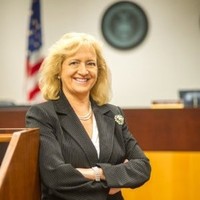Karen Hastings

Alumna combines engineering expertise with long-held interest in law
Karen Hastings graduated from the University of Maine in 1981 with a degree in chemical engineering and received her law degree from George Mason University in 1988. Since 2007, she has served as an Administrative Patent Judge with the U.S. Patent and Trademark Office (USPTO).
Hastings was intrigued by the USPTO from the moment she learned about its existence.
“I read an article when I was a junior in high school about this hot field called patent law,” she recalls. “I was intrigued right away, but since I knew I had to pay my own way through college and law school, it took me a while to get there.”
While she was still in high school, Hastings set her sights on UMaine. She participated in the UMaine College of Engineering’s High School Juniors Program, and afterwards, Stanley Marshall of the UMaine Pulp and Paper Foundation encouraged the high school senior to apply for a lab technician position to gain further experience. Hastings was accepted, and the following summer she worked for S.D. Warren near her hometown of Portland, Maine.
“This confirmed my interest in chemical engineering as a possible entry into the paper making field,” Hastings explains. “I received a four-year merit-based tuition scholarship from the Pulp and Paper Foundation, and never looked back.”
This was Hastings entry into chemical engineering at the University of Maine, where she immediately involved herself in various areas. She was a co-op student project engineer for Westvaco (now New Page Corp.) in western Maryland her junior year at UMaine, and as a senior, she was also a laboratory instructor for the chemistry department. The hands-on, real-world work pushed Hastings to excel.
“It was a great hands-on practical opportunity,” she says. “I still maintain friendships with people I met there.”
Headed to Washington
After graduation, Hastings accepted a job in the paper making field from Procter & Gamble in Mehoopany, PA. At that point, however, Hastings says she already knew ultimately what she wanted to do was pursue her career in patent law.
“So I applied at the USPTO, where I knew I would have the opportunity to work as a patent examiner and go to law school in the evenings,” Hastings explains. “I began my career at USPTO in 1983 evaluating patent applications in the paper making industry. The transition from quickly creating solutions to real-world problems to learning about the best cutting-edge innovations in the field was dramatic and interesting.”
Hastings adds, “USPTO and I were a great match, so to speak. The Washington, D.C., area had numerous nighttime programs available. USPTO even paid for some of my job-related legal coursework.”
Today, Hastings’ childhood fascination with the patent office has turned into an actual career. She works as an administrative patent judge – she and her colleagues decide appeals from adverse decisions of patent examiners.
“It is most fulfilling to be involved in the innovation process and to be able to make what I believe is the best decision in each case, and be a part of USPTO history,” Hastings says.
Making her mark
Hastings views that USPTO history as vitally important. The Patent Office is one of the longest standing and most impactful institutions of today’s society.
“While the first Patent Act was enacted in 1790, legislation that formalized the Board of Patent Appeals and Interferences (now called the Patent Trial and Appeal Board) was implemented under President Lincoln in 1861,” Hastings shares. “Even prior to Abraham Lincoln becoming president, he would famously say that the patent laws ‘added the fuel of interest to the fire of genius, in the discovery and production of new and useful things.’”
Hastings credits the solid foundation in engineering gained at UMaine with preparing her for a thriving career.
“UMaine delivered a top-rate education in engineering. I also had a concentration in mechanical engineering,” she says. “The analytical approach required in math and science courses, and particularly in the engineering disciplines, laid a foundation that proved useful for so many aspects of my career and my life.”
Today, the engineer turned patent lawyer has made her dreams a reality, through a lot of patience and hard work. Her advice to others looking to do the same with their dreams?
“Set a goal and plan how to reach it. Don’t be afraid to change it along the way. Have fun and be willing to try new job experiences as much as possible. I feel like I have experienced at least six different careers at USPTO and I enjoyed every one of them.”
